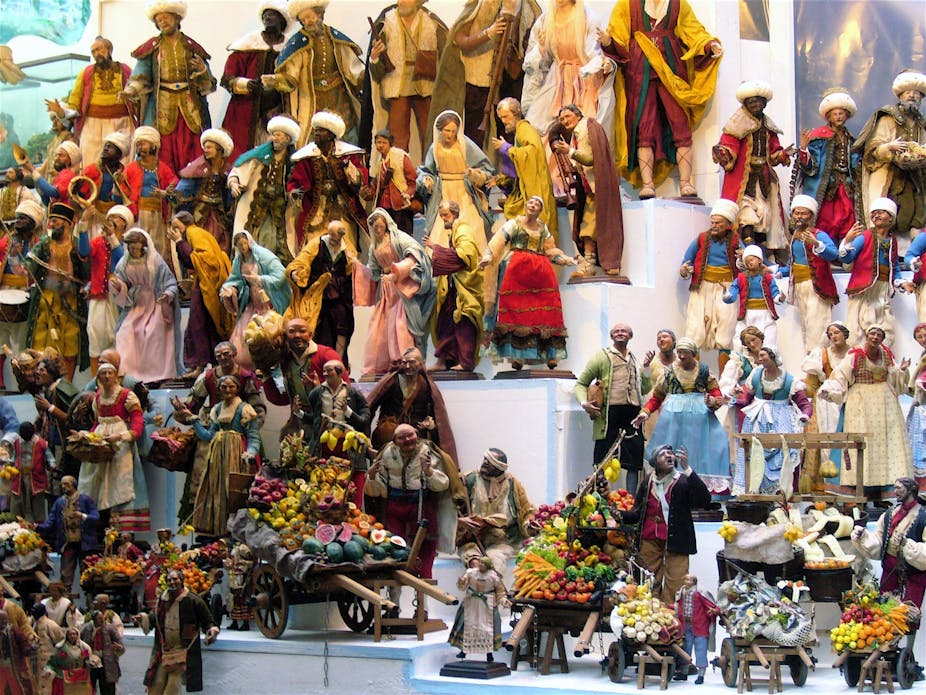There’s a scene in the film Love Actually where a little girl announces that she’ll be playing “first lobster” in the school nativity play. “There was more than one lobster present at the birth of Jesus?” asks her surprised mum – causing the girl to sigh in exasperation at such profound levels of parental ignorance.
Similar exchanges may have taken place in hundreds of homes throughout the UK this year, if a recent poll by the parenting website Netmums is anything to go by. Nearly half the respondents said that their local primary school had abandoned the conventional nativity in favour of a “modernised” version, in which characters like Elvis, spacemen and even recycling bins starred alongside Mary, Joseph and the baby, Jesus.
Public opinion about these new plays is divided. Some people view them as evidence for the increasing marginalisation of Christianity in Britain, while others think they are a perfectly appropriate reflection of a progressive, culturally-diverse society. But all commentators have made the same basic assumption that the modern nativities represent a break in tradition – that they are a product of uniquely 21st-century attitudes to Christmas and religion.

A very different picture emerges, however, if we look across Europe towards southern Italy, and the centuries-old Neapolitan tradition of the model presepe (“nativity scene”). Naples is the undisputed world capital of the presepe, and the historic street of San Gregorio Armeno is the industry’s beating heart.
At any time of the year you can walk around the many stalls, admiring the array of hand-made backdrops and ceramic figurines. Every shop on the street sells the traditional religious characters: Jesus, Mary and Joseph, the shepherds, the angels and the kings. But they also sell figurines of ordinary folk and street merchants, often dressed in 18th-century costumes. Popular types include the butcher with his bloody axe, the baker putting pizza dough in a stone oven and the fishmonger touting his tiny wares, which include glistening sardines, miniature calamari, and – yes, you guessed it – shiny pink lobsters.

Then there are the figurines of modern celebrities: the footballers, politicians, pop-stars, even British royals. All are allowed to travel back in time to join the holy family in Bethlehem. Some figures are perennial favourites, such as the brilliant Neapolitan comedian Massimo Troisi, who achieved worldwide fame as the star of Il Postino.
Each year the artists of San Gregorio also produce new figurines in response to current events, including Barack Obama, Silvio Berlusconi’s latest girlfriend or the entire cast of the Italian Big Brother. This year, the new Italian prime minister, Matteo Renzi, has pride of place on the stalls, while poor old Berlusconi has been relegated to the back rows, his price discounted by 50% to reflect his diminished role in the media and government.

This kind of creative mixing-up of figures from different historical periods has been a feature of the Neapolitan presepe since at least the 18th century. One traveller’s diary records his surprise at seeing the birth of Christ attended by Jacobins and Cappuchin monks. Elsewhere in that scene, the Archbishop of Naples was depicted holding out the vial containing the blood of San Gennaro in an attempt to stave off the eruption of Vesuvius.
But although the tradition is deeply entrenched in Naples, the figurines sold at San Gregorio Armeno continue to be a source of puzzlement to many visitors to the city. Many are confused by this medley of pop culture and religion. It’s certainly tricky to reconcile the holiness of the Nativity with the strange humour and gritty realism of the presepe – whose stock types include a breastfeeding woman and a man shown defecating on the floor.

But most modern commentators on the presepe see the mixture of sacred and profane as containing a very simple and positive message. Neapolitan theologian Bruno Forte explains that the presepe shows that the birth of Jesus is happening here, and it’s happening now – not in some far-off land entirely disconnected from the present. And while the secular figurines in the Neapolitan presepe cover a spectrum of “ills” (ranging from terrible table manners to the worst kinds of political corruption), all these less-than-perfect figures achieve a kind of redemption by being shown in the presence of the Nativity.
As such, the Neapolitan presepe provides an alternative perspective on the modernised nativity plays currently in production in the UK. Contrary to what most people think, the lobsters and Elvises we’re seeing on stage this Christmas aren’t complete strangers at the Nativity. They find much older counterparts across the seas in Naples. And in Naples, they’re not reactionary gestures or superficial afterthoughts, but part of an age-old tradition, which is underpinned by faith, hope and a genuine desire for inclusivity.

